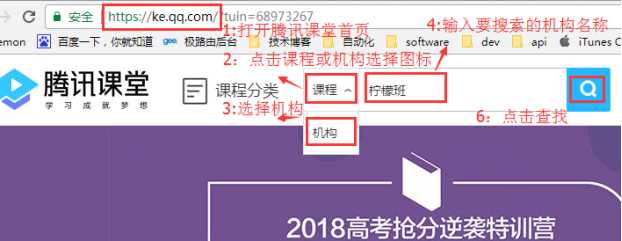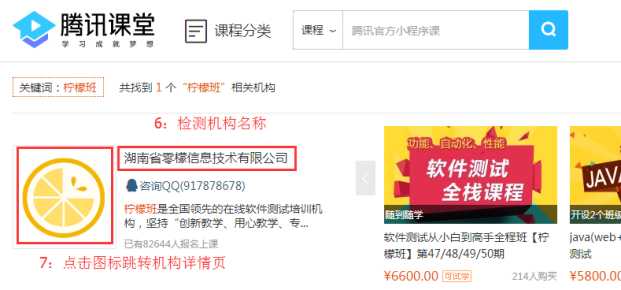标签:object actor detail cto openurl 思想 span arch init
先来看一个在腾讯课堂首页搜索机构的操作步骤:
1:首先打开腾讯课堂的首页:https://ke.qq.com
2:点击课程或机构的下拉选择图标
3:选择机构
4:在搜索框输入要搜索的机构名称
5:点击查找图标查找机构,跳转到查找结果页面
6:检查查找出的机构名称
7:点击机构logo跳转详情页面
上述操作涉及到两个页面,腾讯课堂首页和搜索结果页,操作图示如下:
1:腾讯课堂首页

2:搜索结果页面

使用webdirver的api完成模拟上述步骤代码如下:
SearchCase.java
1 package com.lemon.auto.po;
2
3 import org.openqa.selenium.By;
4 import org.openqa.selenium.WebDriver;
5 import org.openqa.selenium.firefox.FirefoxDriver;
6
7 public class SearchCase {
8
9 public static void main(String[] args) {
10 //设置火狐的可执行文件的路径
11 System.setProperty("webdriver.firefox.bin", "D:/Program Files/Mozilla Firefox/firefox.exe");
12 //创建一个火狐驱动
13 WebDriver driver = new FirefoxDriver();
14
15 //1:打开腾讯课堂首页
16 driver.get("https://lemon.ke.qq.com");
17 //2:定位下拉图标,并点击
18 driver.findElement(By.cssSelector("i[class=‘icon-font i-v-bottom-small‘]")).click();
19 //3:定位课程或机构的下拉选择图标,并点击
20 driver.findElement(By.cssSelector("span[class=‘mod-search-dropdown-item‘]")).click();
21 //4:定位搜索输入框,并输入搜索内容“柠檬班”
22 driver.findElement(By.id("js_keyword")).sendKeys("柠檬班");
23 //5:定位搜索图标,并点击,进行搜索
24 driver.findElement(By.id("js_search")).click();
25 //6:获得机构名称
26 String agencyName = driver.findElement(By.cssSelector("h2[class=‘search-agency-name‘]")).getText();
27 System.out.println(agencyName);
28 //7:定位logo,并点击调整机构详情页面
29 driver.findElement(By.cssSelector("a[href=‘//lemon.ke.qq.com‘]")).click();
30
31 //关闭当前窗口
32 driver.close();
33 }
34 }
上述代码简单而清晰,但如果每个测试用例都这样去写的话,将会出现非常多的重复性代码,可维护性较低,因此,在使用Selenium WebDirver进行自动化开发时,可以使用po(页面对象)编程的思想,减少重复性代码、提高代码的可维护性。
一:po的概念与思想
po是page object的缩写,即页面对象。使用po是对页面进行抽象或者说建模的过程,需要把页面当作一个对象。
面向对象编程语言中,进行面向对象编程需要考虑以下两点:
1:对象的属性(全局变量)
2:对象的行为(函数)
po思想也是一样,对页面进行抽象时,把页面的一个一个的web元素设计为页面对象的属性,把页面上的操作(如点击、输入等)设计为页面对象的行为
二:po中元素的定位
Selenium提供了许多注解和Api可以方便的定位元素和初始化元素,如下是腾讯课堂首页下拉选择机构图标的声明方式:
1 @FindBy(css="i[class=‘icon-font i-v-bottom-small‘]")
2 @CacheLookup
3 public WebElement select_icon;
三行代码释义:
1、@FindBy(css="i[class=‘icon-font i-v-bottom-small‘]")
指定了要元素的定位方式,如上表示以cssSelector方式进行定位,还有其他7种写法@FindBy(id="xxx")、@FindBy(name="xxx")...
2、@CacheLookup
表示缓存查找到元素,重复使用可提高查询速度
3、public WebElement select_icon;
声明一个web元素类型的全局变量
三:po中元素的初始化
Po提供了 PageFactory.initElements()来初始化页面元素,把查找的元素赋值到我们定义的属性(全局变量)上面
为了非常方便的进行页面元素的初始化,我们把该方法放置到页面类型的构造方法中,当调用该构造方法创建页面对象时,会调用该方法同时初始化页面的元素
代码如下:
1 public KeqqHomePage() {
2 PageFactory.initElements(driver, this);
3 }
四:页面行为抽象
元素初始化后,通过操作元素(如点击,输入)即可完成页面的功能,po中对页面功能的抽象,则提现为声明一个一个的对象方法
如下是页面选择机构的行为的抽象:
1 public void selectOrg(){
2 //选择机构需要进行两步操作,首先点击下拉图标,然后点击机构选项,
3 //两步操作写入到该方法,页面对象调用该对象方法,则可完成选择结构的行为
4 select_icon.click();
5 org_item.click();
6 }
下面是对“腾讯课堂首页”页面进行抽象的完整代码:
KeqqHomePage.java
1 package com.lemon.auto.po;
2 import org.openqa.selenium.WebElement;
3 import org.openqa.selenium.support.CacheLookup;
4 import org.openqa.selenium.support.FindBy;
5 import org.openqa.selenium.support.PageFactory;
6
7 /**
8 * 腾讯课堂首页类
9 * @author tommy
10 * @date 2018年5月11日
11 * @email
12 */
13 public class KeqqHomePage extends BasePage {
14 //下拉图标
15 @FindBy(css = "i[class=‘icon-font i-v-bottom-small‘]")
16 @CacheLookup //缓存元素,重复使用提高效率
17 public WebElement select_icon; //首页上选择图标
18
19 //机构元素
20 @FindBy(css = "span[class=‘mod-search-dropdown-item‘]")
21 @CacheLookup
22 public WebElement org_item;//结构选项
23
24 //输入框
25 @FindBy(id = "js_keyword")
26 @CacheLookup
27 public WebElement search_input;
28
29 //搜索按钮
30 @FindBy(id = "js_search")
31 @CacheLookup
32 public WebElement search_btn;
33
34 //页面的url
35 private static final String HOME_PAGE_URL = "https://ke.qq.com";
36
37 //打开首页
38 public void openUrl() {
39 driver.get(HOME_PAGE_URL);
40 }
41
42 /**
43 * 关闭浏览器
44 */
45 public void close() {
46 driver.quit();
47 }
48
49 //默认构造方法
50 public KeqqHomePage() {
51 //当前页面、当前对象
52 PageFactory.initElements(driver, this);
53 }
54
55 //2:方法(行为)
56 /**
57 * 选择机构
58 */
59 public void selectOrg() {
60 //选择机构需要进行什么操作
61 select_icon.click();
62 org_item.click();
63 }
64
65 /**
66 * 输入内容并且搜索---》返回一个结果页面
67 */
68 public SearchResultPage typeContentAndSearch(String content) {
69 //输入框输入内容
70 search_input.sendKeys(content);
71 //搜索按钮点击
72 search_btn.click();
73 return new SearchResultPage();
74 }
75 }
其中继承的父类BasePage仅仅只包含一个静态全局变量driver,方便其他页面继承直接使用
BasePage.java
1 package com.lemon.auto.po;
2 import org.openqa.selenium.WebDriver;
3 import com.lemon.auto.BrowerSelector;
4
5 public class BasePage {
6 //全局的webdirver
7 protected static WebDriver driver = BrowerSelector.getWebDriver();
8 }
其中BrowerSelector.getWebDriver()方法是封装好的一个工具类,用来启动浏览器,得到driver对象用的,在后面的源代码网盘链接中可以下载到。
相同的方式对“结果页面”进行抽象,代码如下:
SearchResultPage.java
1 package com.lemon.auto.po;
2
3 import org.openqa.selenium.WebElement;
4 import org.openqa.selenium.support.CacheLookup;
5 import org.openqa.selenium.support.FindBy;
6 import org.openqa.selenium.support.PageFactory;
7
8 public class SearchResultPage extends BasePage {
9
10 //logo图标
11 @FindBy(css = "a[href=‘//lemon.ke.qq.com‘]")
12 @CacheLookup
13 public WebElement logo_icon;
14
15 //机构名label
16 @FindBy(css = "h2[class=‘search-agency-name‘]")
17 @CacheLookup
18 public WebElement agency_name_label;
19
20 public SearchResultPage() {
21 PageFactory.initElements(driver, this);
22 }
23
24 /**
25 * 校验搜索结果
26 */
27 public void checkSearchResult() {
28 System.out.println(agency_name_label.getText());
29 }
30
31 /**
32 * 到机构的详情页面
33 */
34 public void toAgencyDetail() {
35 logo_icon.click();
36 }
37
38 }
执行测试的类,代码如下:
Tester.java
1 package com.lemon.auto.po;
2
3 public class Tester {
4
5 public static void main(String[] args) throws InterruptedException {
6 //1:打开腾讯课堂首页,创建页面对象模型
7 KeqqHomePage homePage = new KeqqHomePage();
8 homePage.openUrl();
9 //2:选择机构
10 homePage.selectOrg();
11 //3:输入内容并且点击搜索
12 SearchResultPage resultPage = homePage.typeContentAndSearch("柠檬班");
13 //4:检测结果
14 resultPage.checkSearchResult();
15 //5:到机构的详情页面、
16 resultPage.toAgencyDetail();
17 Thread.sleep(10000);
18 //关闭浏览器
19 homePage.close();
20 }
21 }
总结:
po编程,实质上就是分离页面元素、封装页面元素操作的过程,将可能变化的页面元素单独映射到对象属性、将页面元素操作抽象成函数,让我们以面向对象方式理解抽象一个页面,实际上就是编程中解耦思想的应用,从而简化测试用例的步骤,提高自动化测试代码的可维护性。
附公开课视频和源码百度云链接:
https://pan.baidu.com/s/1GoZyigdWiHIQY3xy9nE2ww 密码:1fgl
标签:object actor detail cto openurl 思想 span arch init
原文地址:https://www.cnblogs.com/happy521/p/9146242.html